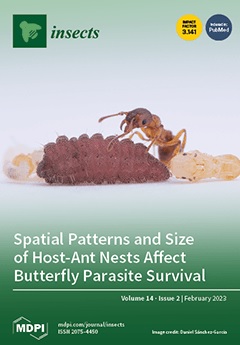Ver ítem
- xmlui.general.dspace_homeCentros Regionales y EEAsCentro Regional Tucumán - Santiago del EsteroEEA FamailláArtículos científicosxmlui.ArtifactBrowser.ItemViewer.trail
- Inicio
- Centros Regionales y EEAs
- Centro Regional Tucumán - Santiago del Estero
- EEA Famaillá
- Artículos científicos
- Ver ítem
Behavioural and Electrophysiological Response of Anastrepha fraterculus (Diptera: Tephritidae) to a γ-Lactone Synthetic Semiochemical
Resumen
Attractants are a powerful tool for pest management. The lack of specific attractants for the South American fruit fly, Anastrepha fraterculus, a complex of cryptic species of great economic importance in South America, makes it difficult to monitor the pest in the field. The γ-lactone male sex and aggregation pheromones of several Anastrepha species, naturally released in a 7:3 epianastrephin to anastrephin ratio, and a structurally related naturally
[ver mas...]
Attractants are a powerful tool for pest management. The lack of specific attractants for the South American fruit fly, Anastrepha fraterculus, a complex of cryptic species of great economic importance in South America, makes it difficult to monitor the pest in the field. The γ-lactone male sex and aggregation pheromones of several Anastrepha species, naturally released in a 7:3 epianastrephin to anastrephin ratio, and a structurally related naturally occurring γ-lactone ((±)-trans-tetrahydroactinidiolide) with gem-dimethyl groups (dimethyl) at C(4), were evaluated as potential attractants of this species. Different age and mating conditions of A. fraterculus males and females were evaluated during electroantennography (EAG) and field cage experiments in which polymeric lures were deployed to contain 100 mg of attractant. Epianastrephin and dimethyl were EAG+ for all fly conditions, with epianastrephin eliciting the highest response for both sexes and immature flies showing greater responsiveness than mature flies. In the field cage experiments, immature flies were only attracted to leks; virgin females were attracted to leks, dimethyl, and both epianastrephin-anastrephin formulations (95 and 70 wt.% epianastrephin); mature-mated males were attracted to leks, dimethyl and 70 wt.% epianastrephin; and mature-mated females were only attracted to leks. Our bioassays showed a promising performance of the analog dimethyl since it elicited the same response as epianastrephin, requires fewer steps to synthesize, and contains one less chiral center than the natural pheromones. The attraction to leks was recorded for all mating conditions and ages of flies and suggests that air-borne volatiles of calling males contain cues that could act as sensory traps. The addition of any of these compounds in the synthetic attractants may result in a greater attraction and thus deserves further evaluation. Dose-response experiments will provide additional information to move a step forward and validate the results obtained in open-field conditions.
[Cerrar]

Autor
Goane, Lucía;
Carrizo, Beatriz Noemi;
Ruiz, María Josefina;
Bachmann, Guillermo Enrique;
Milla, Fabian Horacio;
Segura, Diego Fernando;
Kuzmich, Dan;
Walse, Spencer;
Vera, María Teresa;
Fuente
Insects 14 (2) : 206 (February 2023)
Fecha
2023-02
Editorial
MDPI
ISSN
2075-4450
Formato
pdf
Tipo de documento
artículo
Palabras Claves
Derechos de acceso
Abierto
 Excepto donde se diga explicitamente, este item se publica bajo la siguiente descripción: Creative Commons Attribution-NonCommercial-ShareAlike 2.5 Unported (CC BY-NC-SA 2.5)
Excepto donde se diga explicitamente, este item se publica bajo la siguiente descripción: Creative Commons Attribution-NonCommercial-ShareAlike 2.5 Unported (CC BY-NC-SA 2.5)


